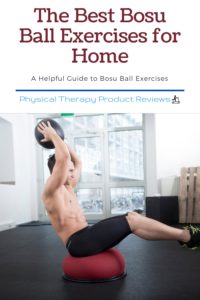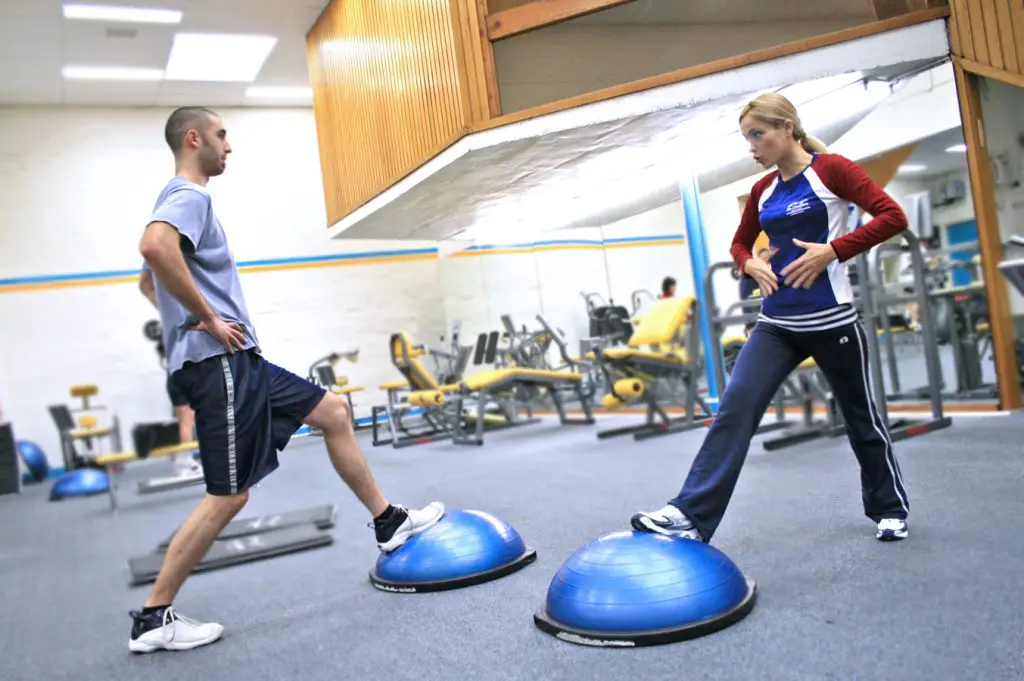The Best Bosu Ball Exercises To Improve Strength and Balance
What is a Bosu Ball?
If you’ve seen someone using what looks like a large swiss ball cut in half and thought “What is that,” this a Bosu Ball. Bosu stands for “both sides up,” meaning that you can use either the blue squishy side or the sold black. If by chance you are reading this and are thinking “I have no idea what a Bosu Ball is,” imagine a rubber ball that is split down the middle and then attached to a solid platform with handles. This unique shape and design allow the Bosu Ball to be used in a variety of different exercise and balance needs.
How to Use a Bosu Ball
The Bosu ball can be used in a few different ways. The first is with the soft rubber surface facing upwards. This allows a stable flat base on the floor but an unstable surface to exercise on. It can also be used with unstable surface down and the solid flat platform facing upwards. Used either way allows for great training, just remember to be safe getting on and off. Our favorite bosu ball is made by RitFit because it comes with handles, a pump, exercise card, and is made of great quality.
What are the Benefits of a Bosu Ball?
 Based on the creative design there are many great benefits of using a Bosu Ball. It makes any ordinary exercise much more unstable and thus makes us work harder. Some of the benefits include:
Based on the creative design there are many great benefits of using a Bosu Ball. It makes any ordinary exercise much more unstable and thus makes us work harder. Some of the benefits include:
- Improving balance
- Increased core strength
- Great muscle co-activation
- Great neurological activity
- Increase in energy use and potential calorie burn
Need a Bosu Ball for home? Check out our reviews of the Best Bosu Balls for Home

The Best Bosu Ball Exercises to Get a Full Body Workout
The Bosu ball is one of the best ways to get a full body workout. When using a Bosu ball the aspect of instability makes all of the major muscle groups work together. You calves, quads, hips, and core have to work extremely hard to keep you upright much less perform the actual movement for a given exercise.
Bosu Ball Squat
- Start with the rubber side down and be careful getting on.
- Make sure to keep the weight equal between your feet to keep the bosu stable.
- Squat down slowly maintaining control.
- To make it more challenging try with a resistance band around the knees.
Bosu Ball Lunge
- This exercise can be performed with the front leg on the bosu ball or the back leg on the bosu ball. Either way it provides a great challenge to maintain the split stance balance.
- This is killer leg workout
- Try to maintain the hip, knee, and second toe in straight line
- Perform the motion slowly to really get the benefit of the lunge exercise
Need an inexpensive resistance band? Check out our review of the best resistance bands on Amazon!
V-sit on Bosu Ball
- One of the staple core exercises performed on a bosu ball.
- Start by sitting in the middle of the ball, rubber side up
- Bring your chest and legs together while maintaining your sitting balance.
- Then return to your legs and trunk straight
Plank on a Bosu Ball
- The Bosu plank can be performed with either the rubber or the solid black side facing upwards. The black side up does make it harder to perform.
- Keep your core tight and try to hold for 60 seconds or work up to a full 60 seconds.
- You can perform from your knees or from your elbows
- This exercise is great for core work, shoulder stability and low back strength
Push Ups on Bosu Ball
- Performing push ups on a bosu is a challenging and fun way to work your pecs and shoulder while also getting a core and back workout.
- Bring the arms close together to target your triceps or elbows far out to target the pecs
- Don’t let your low back sag to prevent aggravating the back
Plank Rows on Bosu Ball
- Absolutely stellar upper body exercise that makes you stabilize on one arm and produce strength and power on the other arm.
- Not to mention that this requires solid core strength to maintain a plank position
- Don’t let the body rotate when performing.
Single Leg Bridge on Bosu Ball
- One of the best exercises to target to posterior chain of the leg including the glutes, hamstrings, and calves.
- Promotes great co-contraction of the targeted leg and a great core exercise.
- Start by activating the core, squeezing the glutes and then lifting the hips up to the ceiling.
The Best Bosu Ball Exercises to Improve Balance
Balance is a crucial skill and part of our everyday life. As we age or become injured, our muscles slowly atrophy and we begin to lose our balance. Balance and the the lack of balance is much more of issue than one may originally think.
In the elderly population, a simple fall can be fatal. Greater than 20% of women who fall over the age of 65 weill become disabled. Even worse, about another 18-20% of those who fall will die within a year of the fall. For the elderly, balance is really a “use it or lose it” skill. If you don’t push yourself and challenge your balance, your body’s balance system will slowly deteriorate. You won’t even realize that your balance has decreased until it’s too late. Each year after we turn 30 our balance begins to decrease little by little. Therefore it is key, to work and challenge yourself with balance exercises in your 30’s, 40’s, 50’s, and 60’s.
On the flip side, balance is extremely important in athletic performance and over injury prevention. Core strength and the ability to maintain body position such as balance have been key indicators for increased risk of injury in Ankle Sprains, Patellofemoral Pain Syndrome, Hip Labral Pathology, and especially in Risk of ACL injury. The more that you can combine your strengthening exercises with balance exercises, the better your performance and you will have a lower risk of serious injury
Deadlifts on a Bosu Ball
- One of the best functional exercises out there. This exercises is a movement that humans perform on a daily basis but often perform with incorrect form.
- By performing the deadlift a bosu ball, you make all the muscles that focus on balance work that much harder.
- Start by standing on the bosu ball with weights in your hands
- Begin the movement with a slight bend in the knees. Start by pushing your hips backwards first or hinging at the hips.
- Slowly lower the weights down the front of the leg until you can’t stretch anymore in the back of the legs
- Slow and controlled bring your hips forward to return to a standing position
- ALL WHILE MAINTAINING YOUR BALANCE
Single Leg Balance on a Bosu Ball
- This exercise is great for entire leg strength and for balance by targeting your hip stabilizers, large knee muscles, and the ankle stabilizers.
- To make it more challenging first start with the eyes open. If that is too easy, then try to perform with the eyes closed and take your vision out of the equation.
- Try to make sure that the hips and knees are bent to make it require more muscle activation and work to keep you upright. This sounds much easier than it is and one of the single best exercises to improve your balance
Calf Raises on a Bosu Ball
- Another variation of a single leg balance but targeting our largest lower leg muscle group.
- Start by doing a double leg calf raise first to get the feel of the balance requirements and then progress to a single leg calf raise on the bosu ball.
- This will really target the ankle and lower leg muscles which is one of the main areas that we control balance and some of our most important muscles needed for explosive running and jumping.
Weight Shifts / Skiers on Bosu Ball
- This exercise if another one of our favorites because it is so functional! When performing you are standing with the black side up and shifting side to side and pushing the limits of our balance
- Be careful getting on and may be best performed near a counter or something to grab onto if you lose your balance
- This exercise also strengthens the quads, glutes, and lower legs making it a great strength and conditioning exercise
Disclaimer
Please be careful whenever pushing your balance. Always check with a physician before starting an exercise program. Perform these exercises at your own risk as we are not responsible for any injuries that might occur when performing these exercises. Please start at your own skill level.
Disclaimer: The information provided in this post is for educational purposes only. This is not a substitute for a medical appointment. Please refer to your physician before starting any exercise program.


